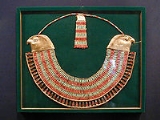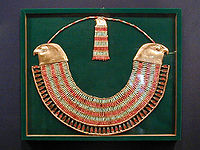
Neferu-Ptah
Encyclopedia

Ptah
In Ancient Egyptian Religion, Ptah was the deification of the primordial mound in the Ennead cosmogony, which was more literally referred to as Ta-tenen , meaning risen land, or as Tanen, meaning submerged land, though Tatenen was a god in his...
”) was a daughter of the Egyptian king Amenemhat III
Amenemhat III
Amenemhat III, also spelled Amenemhet III was a pharaoh of the Twelfth Dynasty of Egypt. He ruled from c.1860 BC to c.1814 BC, the latest known date being found in a papyrus dated to Regnal Year 46, I Akhet 22 of his rule. He is regarded as the greatest monarch of the Middle Kingdom...
(c. 1860 BC to 1814 BC) of the 12th dynasty
Twelfth dynasty of Egypt
The twelfth dynasty of ancient Egypt is often combined with Dynasties XI, XIII and XIV under the group title Middle Kingdom.-Rulers:Known rulers of the twelfth dynasty are as follows :...
. Her sister was the Pharaoh Sobekneferu
Sobekneferu
Sobekneferu was an Egyptian pharaoh of the twelfth dynasty. Her name meant "the beauty of Sobek." She was the daughter of Pharaoh Amenemhat III. Manetho states she also was the sister of Amenemhat IV, but this claim is unproven. Sobekneferu had an older sister named Nefruptah who may have been...
(“Beauty of Sobek
Sobek
Sobek , and in Greek, Suchos was the deification of crocodiles, as crocodiles were deeply feared in the nation so dependent on the Nile River...
”).
Neferuptah is one of the first royal women whose name was written inside a cartouche
Cartouche
In Egyptian hieroglyphs, a cartouche is an ellipse with a horizontal line at one end, indicating that the text enclosed is a royal name, coming into use during the beginning of the Fourth Dynasty under Pharaoh Sneferu, replacing the earlier serekh...
. Although she never had the title 'king's wife', she must have had a special status; it is possible she was regarded as a future ruler.
Her titles included member of the elite, great of favour, great of praise and beloved king's daughter of his body. A burial for her was prepared in the tomb of her father at Hawara
Hawara
Hawara is an archaeological site of Ancient Egypt, south of the site of Crocodilopolis at the entrance to the depression of the Fayyum oasis. The first excavations at the site were made by Karl Lepsius, in 1843...
. However, she was not buried there, but in a small pyramid at Hawara. Her tomb was found intact in 1956 and still contained her jewellery, a granite sarcophagus, three silver vases and other objects. The granite sarcophagus was inscribed with a short offering formula. Inside the sarcophagus were found the decayed remains of two wooden coffins. The outer one was decorated with inscribed gold foil. Identical inscriptions were found on the sarcophagus of Queen Hatshepsut
Hatshepsut
Hatshepsut also Hatchepsut; meaning Foremost of Noble Ladies;1508–1458 BC) was the fifth pharaoh of the eighteenth dynasty of Ancient Egypt...
, who lived about 300 years later. Her tomb is mentioned on a papyrus found at Lahun. She is depicted next to her father in the temple at Medinet Maadi
Medinet Maadi
Medinet Maadi is a site in the southwestern Fayum region of Egypt where a temple of the cobra-goddess Renenutet was founded during the reigns of Amenemhat III and Amenemhat IV...
. Objects belonging to her include a sphinx of black granite and the fragment of a statue found on Elephantine
Elephantine
Elephantine is an island in the River Nile, located just downstream of the First Cataract at the southern border of Ancient Egypt. This region is referred to as Upper Egypt because the land is higher than that near the Mediterranean coast. The island may have received its name because it was a...
Literature
- Flinders Petrie: Kahun, Gurob, and Hawara, London 1890 (online: http://www.lib.uchicago.edu/cgi-bin/eos/eos_title.pl?callnum=DT73.K3P5_cop1)
- N. Farag: The discovery of Neferwptah, 1971

